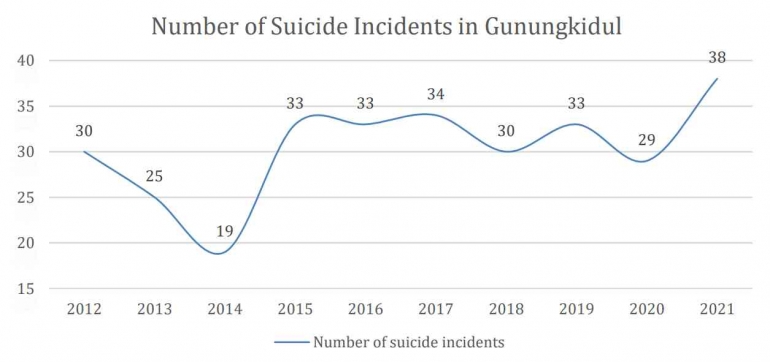Judul: Breaking the Myth of Pulung Gantung: A Socio-Economic Lens on Gunungkidul's Suicide Saga
Author: Revanda Ardelia
Jika anda mengalami depresi atau gangguan kesehatan mental lain dan memiliki keinginan
untuk melukai diri sendiri dan/atau kecenderungan untuk bunuh diri, segera mencari
pertolongan profesional atau dukungan dari orang-orang terdekat.
If you are suffering from depression or other mental disorders and having the urge to harm
yourself and/or having suicidal intentions, please seek professional help or support from
family or friends immediately.
Suicide Hotline:
112 (Emergency number)
119-8 (Dial 119 and press extension 8) (SEJIWA Counseling Service)
+62-811-3855-472 (LISA Suicide Prevention Helpline)
0812-8156-2620 (Call center Halo Kemenkes)
Please visit the nearest emergency center and inform the medical staff that you are
experiencing suicidal thoughts and require close monitoring.
Gunungkidul, a region in Daerah Istimewa Yogyakarta province, is famous for its captivating caves and beaches. The name "Gunungkidul" means "mountains in the south" for its territory which lies within mountains range in southern Yogyakarta. However, behind its captivating beauties, Gunungkidul is also a place for human tragedy, suicide. Gunungkidul is known for its high number of suicide among other regions in Yogyakarta, with up to 4.3% incidence rate over the last decade (Nurdiyanto et al., 2022). So, why does a region with rich natural wonders hold such a high number of the said human tragedy?
Given the data over the last decade, starting from 2012 to 2021, suicide case in Gunungkidul reached as high as 304 cases with an average of 30 cases per year. The number did not decrease significantly from the previous decade, 2003 to 2012, which had been around 330 cases reported, with an average 33 cases per year. Between 2015 and September 2017, there were 22 suicides committed by individuals aged 71 to 80. Most of these cases were caused by despair due to chronic illnesses that were not cured and loneliness due to being left behind by their families. In addition, ages 41 to 50 who committed suicide were related to family issues such as economic problems, marital problems related to cheating or divorce, and even the shame of having a disabled child. While those who committed suicide before the age of 20 were mostly due to breakups with schoolmates (Andari et al., 2022).

When talking about suicide in Gunungkidul, some locals often associated it with the phenomenon Pulung Gantung. Pulung Gantung is portrayed as a fireball with a tail that glows red and yellowish. It travels from a spot above the sky to another. The locals were led to believe that the location where Pulung Gantung had fallen would be the location for the resident to take their own life (Andari et al., 2022). However, Pulung gantung is just a mere myth. It cannot be taken into account nor does it explain the reason behind Gunungkidul's high suicide rate. This study aims to unveil the complexity in the situation; from unemployment to mental health disorders that eventually lead the suicide saga in Gunungkidul.
Socio-economic Factor: Unemployment, Poverty, and Debts
In the sixties, Gunungkidul was already known as a place that was barren and prone to drought. The tragedy of suicide in Gunungkidul was more closely associated with poverty, drought, and the difficulties of daily life. Most suicides occur in very dry, poor and difficult areas. Remarkably, over the years, the trajectory of Gunungkidul's economy has been steadily on an upward ascent. However, despite the economic growth in recent years, these improvements have not succeeded in preventing suicides (Andari et al., 2022).
Using Typology Klassen, an analysis tool used to categorize the growth in each region/city in DIY, namely the Fast Growing Region, Fast Forward and Fast Growing region, the Depressed Region, and the Relatively Backward Region, we can classify the regions/city in DIY into 3 categories (Figure 1.2). The GDP growth rate and per capita income in the Fast Growing Region are higher than the average for the entire region. The Fast Forward and Fast Growing Region is essentially one that has huge potential for growth but hasn't been fully utilized as of yet. The Relatively Backward Region is characterized by a growth rate and per capita income that lag behind the national average. This indicates that the rate of socio-development and economic growth in this area is still comparatively low. Lastly, the Depressed Region is comparatively developed, but in recent years, the suppression of the region's primary activity has caused the growth rate to slow down (Nurpita & Nastiti, 2016).

Based on Klassen Typology analysis, Gunungkidul is categorized into Relatively Backward Region along with Kulon Progo. The economic growth in Gunungkidul, unfortunately, is yet to be said impressive. During the pandemic, Gunungkidul experienced a declining economic growth, reaching a low of -0.69%. Although it has rebounded significantly to 5.37% in 2022, its growth is still lagging behind Kulon Progo, which achieved a 6.57% economic growth rate (Badan Pusat Statistik, 2023).


















